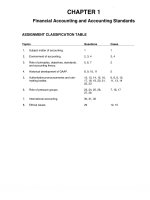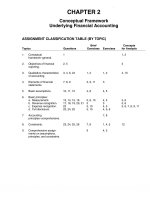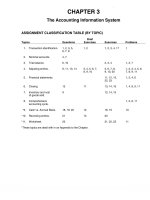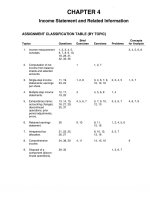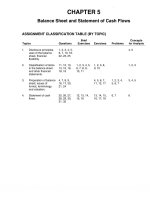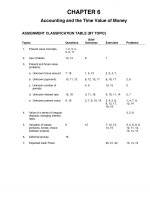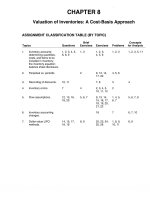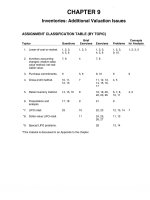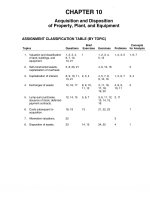Solution manual intermediate accounting 14e kieso weygandt warfield ch17
Bạn đang xem bản rút gọn của tài liệu. Xem và tải ngay bản đầy đủ của tài liệu tại đây (791.76 KB, 105 trang )
CHAPTER 17
Investments
ASSIGNMENT CLASSIFICATION TABLE (BY TOPIC)
Topics
Questions
1. Debt securities.
Brief
Exercises Exercises
1, 2, 3, 13
Problems
1
4, 7
(a) Held-to-maturity.
4, 5, 7, 8,
10, 13, 21
1, 3
(b) Trading.
4, 6, 7, 8,
10, 21
4
(c)
4, 7, 8, 9,
10, 11, 21
2, 10
4
1, 2, 3, 4, 7
2. Bond amortization.
8, 9
1, 2, 3
3, 4, 5
1, 2, 3
3. Equity securities.
1, 12, 16
Available-for-sale.
2, 3, 5
Concepts
for Analysis
1, 7
4
1, 4
1
1, 4
4, 7
(a) Available-for-sale.
7, 10, 11,
15, 21
5, 8
6, 8, 9, 11,
12, 16,
19, 20
5, 6, 8, 9,
10, 11, 12
1, 2, 3
(b) Trading.
6, 7, 8, 10,
14, 15, 21
6
6, 7,
14, 15
6, 8
1, 3
(c)
16, 17, 18,
19, 20
7
12, 13,
16, 17
8
5, 6
4. Comprehensive income.
22
9
10
10, 12
5. Disclosures of investments.
21
8, 9
5, 8, 9, 10,
11, 12
6. Fair value option.
25, 26, 27
19, 20, 21
7. Impairments.
24
8. Transfers between
categories.
23
Equity method.
*9. Derivatives.
*10. Variable Interest Entities.
10
28, 29, 30, 31,
32, 33, 34, 35
18
3
1, 3, 7
22, 23, 24,
25, 26, 27
13, 14, 15,
16, 17, 18
36, 37
*This material is dealt with in an Appendix to the chapter.
Copyright © 2011 John Wiley & Sons, Inc. Kieso, Intermediate Accounting, 14/e, Solutions Manual (For Instructor Use Only)
17-1
ASSIGNMENT CLASSIFICATION TABLE (BY LEARNING OBJECTIVE)
Learning Objectives
Brief
Exercises
Exercises
Problems
1.
Identify the three categories of debt securities
and describe the accounting and reporting
treatment for each category.
2.
Understand the procedures for discount and
premium amortization on bond investments.
1, 2, 3, 4
2, 3, 4, 5, 21
1, 2, 3, 4, 7
3.
Identify the categories of equity securities and
describe the accounting and reporting
treatment for each category.
5, 6, 8
1, 6, 7, 8, 9,
11, 12, 14,
15, 16, 19,
20, 21
3, 5, 6, 8, 9,
10, 11, 12
4.
Explain the equity method of accounting and
compare it to the fair value method for equity
securities.
7
12, 13,
16, 17
8
5.
Describe the accounting for the fair value
option.
19, 20, 21
8, 9, 10, 12
6.
Discuss the accounting for impairments
of debt and equity investments.
10
18
7.
Explain why companies report reclassification
adjustments.
9
10
8.
Describe the accounting for transfer of
investment securities between categories.
*9.
1
Explain who uses derivatives and why.
*10.
Understand the basic guidelines for
accounting for derivatives.
*11.
Describe the accounting for derivative
financial instruments.
22, 26
13, 14, 15
*12.
Explain how to account for a fair value hedge.
23, 25
16, 18
*13.
Explain how to account for a cash flow hedge.
24, 27
17
17-2
Copyright © 2011 John Wiley & Sons, Inc. Kieso, Intermediate Accounting, 14/e, Solutions Manual (For Instructor Use Only)
ASSIGNMENT CHARACTERISTICS TABLE
Item
E17-1
E17-2
E17-3
E17-4
E17-5
E17-6
E17-7
E17-8
E17-9
E17-10
E17-11
E17-12
E17-13
E17-14
E17-15
E17-16
E17-17
E17-18
E17-19
E17-20
E17-21
*E17-22
*E17-23
*E17-24
*E17-25
*E17-26
*E17-27
P17-1
P17-2
P17-3
P17-4
P17-5
P17-6
P17-7
P17-8
P17-9
Description
Investment classifications.
Entries for held-to-maturity securities.
Entries for held-to-maturity securities.
Entries for available-for-sale securities.
Effective-interest versus straight-line bond amortization.
Entries for available-for-sale and trading securities.
Trading securities entries.
Available-for-sale securities entries and reporting.
Available-for-sale securities entries and financial statement
presentation.
Comprehensive income disclosure.
Equity securities entries.
Journal entries for fair value and equity methods.
Equity method.
Equity investment—trading.
Equity investments—trading.
Fair value and equity method compared.
Equity method.
Impairment of debt securities.
Fair Value measurement.
Fair Value measurement.
Fair value option.
Derivative transaction.
Fair value hedge.
Cash flow hedge.
Fair value hedge.
Call option.
Cash flow hedge.
Debt securities.
Available-for-sale debt securities.
Available-for-sale investments.
Available-for-sale debt securities.
Equity securities entries and disclosures.
Trading and available-for-sale securities entries.
Available-for-sale and held-to-maturity debt securities entries.
Fair value and equity methods.
Financial statement presentation of available-for-sale
investments.
Level of
Difficulty
Time
(minutes)
Simple
Simple
Simple
Simple
Simple
Simple
Simple
Simple
Simple
5–10
10–15
15–20
10–15
20–30
10–15
10–15
5–10
10–15
Moderate
Simple
Simple
Moderate
Moderate
Moderate
Simple
Simple
Moderate
Moderate
Moderate
Moderate
Moderate
Moderate
Moderate
Moderate
Moderate
Moderate
20–25
20–25
15–20
10–15
10–15
15–20
15–20
10–15
15–20
15–20
15–20
15–20
15–20
20–25
20–25
15–20
20–25
25–30
Moderate
Moderate
Moderate
Moderate
Moderate
Simple
Moderate
Moderate
Moderate
30–40
30–40
25–30
25–35
25–35
25–35
25–35
20–30
20–30
Copyright © 2011 John Wiley & Sons, Inc. Kieso, Intermediate Accounting, 14/e, Solutions Manual (For Instructor Use Only)
17-3
ASSIGNMENT CHARACTERISTICS TABLE (Continued)
Item
P17-10
P17-11
P17-12
*P17-13
*P17-14
*P17-15
*P17-16
*P17-17
*P17-18
CA17-1
CA17-2
CA17-3
CA17-4
CA17-5
CA17-6
CA17-7
17-4
Description
Gain on sale of securities and comprehensive income.
Equity investments—available-for-sale.
Available-for-sale securities—statement presentation.
Derivative financial instrument.
Derivative financial instrument.
Free-standing derivative.
Fair value hedge interest rate swap.
Cash flow hedge.
Fair value hedge.
Level of
Difficulty
Moderate
Complex
Moderate
Moderate
Moderate
Moderate
Moderate
Moderate
Moderate
Time
(minutes)
20–30
35–45
20–30
20–25
20–25
20–25
30–40
25–35
25–35
Issues raised about investment securities.
Equity securities.
Financial statement effect of equity securities.
Equity securities.
Investment accounted for under the equity method.
Equity investment.
Fair value—ethics.
Moderate
Moderate
Simple
Moderate
Simple
Moderate
Moderate
25–30
25–30
20–30
20–25
15–25
25–35
25–35
Copyright © 2011 John Wiley & Sons, Inc. Kieso, Intermediate Accounting, 14/e, Solutions Manual (For Instructor Use Only)
SOLUTIONS TO CODIFICATION EXERCISES
CE17-1
Master Glossary
(a)
Trading securities are securities that are bought and held principally for the purpose of selling
them in the near term and therefore held for only a short period of time. Trading generally reflects
active and frequent buying and selling, and trading securities are generally used with the
objective of generating profits on short-term differences in price.
(b)
A holding gain or loss is the net change in fair value of a security. The holding gain or loss does
not include dividend or interest income recognized but not yet received or write-downs for otherthan-temporary impairment.
(c)
A cash flow hedge is a hedge of the exposure to variability in the cash flows of a recognized
asset or liability, or of a forecasted transaction, that is attributable to a particular risk.
(d)
A fair value hedge is a hedge of the exposure to changes in the fair value of a recognized asset
or liability, or of an unrecognized firm commitment, that are attributable to a particular risk.
CE17-2
According to FASB ASC 235-10-S99-1 (Notes to Financial Statements—SEC Materials):
(n)
Accounting policies for certain derivative instruments. Disclosures regarding accounting policies
shall include descriptions of the accounting policies used for derivative financial instruments and
derivative commodity instruments and the methods of applying those policies that materially
affect the determination of financial position, cash flows, or results of operation. This description
shall include, to the extent material, each of the following items:
(1) A discussion of each method used to account for derivative financial instruments and
derivative commodity instruments;
(2) The types of derivative financial instruments and derivative commodity instruments accounted
for under each method;
(3) The criteria required to be met for each accounting method used, including a discussion of
the criteria required to be met for hedge or deferral accounting and accrual or settlement
accounting (e. g., whether and how risk reduction, correlation, designation, and effectiveness
tests are applied);
(4) The accounting method used if the criteria specified in paragraph (n)(3) of this section are
not met;
(5) The method used to account for terminations of derivatives designated as hedges or
derivatives used to affect directly or indirectly the terms, fair values, or cash flows of a
designated item;
Copyright © 2011 John Wiley & Sons, Inc. Kieso, Intermediate Accounting, 14/e, Solutions Manual (For Instructor Use Only)
17-5
CE17-2 (Continued)
(6) The method used to account for derivatives when the designated item matures, is sold, is
extinguished, or is terminated. In addition, the method used to account for derivatives
designated to an anticipated transaction, when the anticipated transaction is no longer likely
to occur; and
(7) Where and when derivative financial instruments and derivative commodity instruments, and
their related gains and losses, are reported in the statements of financial position, cash
flows, and results of operations.
Instructions to paragraph 4-08(n).
1. For purposes of this paragraph (n), derivative financial instruments and derivative
commodity instruments (collectively referred to as “derivatives”) are defined as follows:
(i) Derivative financial instruments have the same meaning as defined by generally
accepted accounting principles (see Financial Accounting Standards Board
(“FASB”), Statement of Financial Accounting Standards No. 119, “Disclosure about
Derivative Financial Instruments and Fair Value of Financial Instruments,” (“FAS 119”)
paragraphs 5–7, (October 1994)), and include futures, forwards, swaps, options,
and other financial instruments with similar characteristics.
(ii) Derivative commodity instruments include, to the extent such instruments are not
derivative financial instruments, commodity futures, commodity forwards, commodity
swaps, commodity options, and other commodity instruments with similar
characteristics that are permitted by contract or business custom to be settled in
cash or with another financial instrument. For purposes of this paragraph, settlement
in cash includes settlement in cash of the net change in value of the derivative
commodity instrument (e. g., net cash settlement based on changes in the price of
the underlying commodity).
2. For purposes of paragraphs (n)(2), (n)(3), (n)(4), and (n)(7), the required disclosures
should address separately derivatives entered into for trading purposes and derivatives
entered into for purposes other than trading.
For purposes of this paragraph, trading purposes has the same meaning as defined by
generally accepted accounting principles (see, e. g., FAS 119, paragraph 9a (October
1994)).
3. For purposes of paragraph (n)(6), anticipated transactions means transactions (other
than transactions involving existing assets or liabilities or transactions necessitated by
existing firm commitments) an enterprise expects, but is not obligated, to carry out in the
normal course of business (see, e. g., FASB, Statement of Financial Accounting
Standards No. 80, “Accounting for Futures Contracts,” paragraph 9, (August 1984)).
4. Registrants should provide disclosures required under paragraph (n) in filings with the
Commission that include financial statements of fiscal periods ending after June 15, 1997.
[45 FR 63669, Sept. 25, 1980, as amended at 46 FR 56179, Nov. 16, 1981; 50
FR 25215, June 18, 1985; 50 FR 49532, Dec. 3, 1985; 51 FR 3770, Jan. 30,
1986; 57 FR 45293, Oct. 1, 1992; 59 FR 65636, Dec. 20, 1994; 62 FR 6063,
Feb. 10, 1997]
17-6
Copyright © 2011 John Wiley & Sons, Inc. Kieso, Intermediate Accounting, 14/e, Solutions Manual (For Instructor Use Only)
CE17-3
According to FASB ASC 323-10-35-20 (Investments—Equity Method and Joint Ventures—Subsequent
Measurement):
The investor ordinarily shall discontinue applying the equity method if the investment (and net
advances) is reduced to zero and shall not provide for additional losses unless the investor has
guaranteed obligations of the investee or is otherwise committed to provide further financial support for
the investee.
CE17-4
According to FASB ASC 815-10-45-4 (Derivatives and Hedging—Other Presentation Matters—Balance
Sheet Netting);
Unless the conditions in paragraph 210-20-45-1 are met, the fair value of derivative instruments in a
loss position shall not be offset against the fair value of derivative instruments in a gain position.
Similarly, amounts recognized as accrued receivables shall not be offset against amounts recognized
as accrued payables unless a right of setoff exists.
Copyright © 2011 John Wiley & Sons, Inc. Kieso, Intermediate Accounting, 14/e, Solutions Manual (For Instructor Use Only)
17-7
ANSWERS TO QUESTIONS
1.
A debt security is an instrument representing a creditor relationship with an enterprise. Debt
securities include U.S. government securities, municipal securities, corporate bonds, convertible
debt, and commercial paper. Trade accounts receivable and loans receivable are not debt securities because they do not meet the definition of a security.
An equity security is described as a security representing an ownership interest such as common,
preferred, or other capital stock. It also includes rights to acquire or dispose of an ownership
interest at an agreed-upon or determinable price such as warrants, rights, and call options or put
options. Convertible debt securities and redeemable preferred stocks are not treated as equity
securities.
2.
The variety in bond features along with the variability in interest rates permits investors to shop
for exactly the investment that satisfies their risk, yield, and marketability desires, and permits
issuers to create a debt instrument best suited to their needs.
3.
Cost includes the total consideration to acquire the investment, including brokerage fees and
other costs incidental to the purchase.
4.
The three types of classifications are:
Held-to-maturity:
Debt investments that the enterprise has the
positive intent and ability to hold to maturity.
Trading:
Debt investments bought and held primarily for sale in the
near term to generate income on short-term price differences.
Available-for-sale:
Debt investments not classified as held-to-maturity or trading securities.
5.
A debt investment should be classified as held-to-maturity only if the company has both: (1) the
positive intent and (2) the ability to hold those securities to maturity.
6.
Trading securities are reported at fair value, with unrealized holding gains and losses reported as
part of net income. Any discount or premium is amortized.
7.
Trading and available-for-sale securities should be reported at fair value, whereas held-tomaturity securities should be reported at amortized cost.
8.
$3,500,000 X 10% = $350,000; $350,000 ÷ 2 = $175,000. Wheeler would make the following
entry:
............................................................................................................................... Cash ($4,000,000 X
8% X 1/2).................................................................................................................
160,000
............................................................................................................................... Debt Investments
.................................................................................................................... 15,000
...................................................................................................... Interest Revenue
($3,500,000 X 10% X 1/2)........................................................................................
175,000
9........................................................ Fair Value Adjustment (Available-for-Sale)
89,000
............................................................................................................................... Unrealized Holding
Gain or Loss—Equity
...............................................................................................................................
[$3,604,000 –
($3,500,000 + $15,000)*].......................................................................................
89,000
............................................................................................................................... *See number 8.
17-8
Copyright © 2011 John Wiley & Sons, Inc. Kieso, Intermediate Accounting, 14/e, Solutions Manual (For Instructor Use Only)
10.
Unrealized holding gains and losses for trading securities should be included in net income for
the current period. Unrealized holding gains and losses for available-for-sale securities should be
reported as other comprehensive income and as a separate component of stockholders’ equity.
Unrealized holding gains and losses are not recognized for held-to-maturity securities.
Copyright © 2011 John Wiley & Sons, Inc. Kieso, Intermediate Accounting, 14/e, Solutions Manual (For Instructor Use Only)
17-9
Questions Chapter 17 (Continued)
11.
(a).......................... Unrealized Holding Gain or Loss—Equity
60,000
................................................................................................ Fair Value Adjustment
(Available-for-Sale)...........................................................................................
60,000
(b).......................... Unrealized Holding Gain or Loss—Equity
70,000
................................................................................................ Fair Value Adjustment
(Available-for-Sale)...........................................................................................
70,000
12. Investments in equity securities can be classified as follows:
(a)
Holdings of less than 20% (fair value method)—investor has passive interest.
(b)
Holdings between 20% and 50% (equity method)—investor has significant influence.
(c)
Holdings of more than 50% (consolidated statements)—investor has controlling interest.
Holdings of less than 20% are then classified into trading and available-for-sale, assuming
determinable fair values.
13. Investments in stock do not have a maturity date and therefore cannot be classified as held-tomaturity securities.
14.......................................... Gross selling price of 10,000 shares at $27.50
........................................................................................................... $275,000
......................................................................... Less: Brokerage commissions
..........................................................................................................
(1,770)
........................................................................................... Proceeds from sale
........................................................................................................... 273,230
....................................................................................... Cost of 10,000 shares
.......................................................................................................... (260,000)
.............................................................................. Gain on sale of investments
........................................................................................................... $ 13,230
................................................................................................................. Cash
273,230
......................................................................................................................... Equity Investments
.........................................................................................................................
260,000
......................................................................................................................... Gain on Sale of
Investments......................................................................................................
13,230
15. Both trading and available-for-sale equity securities are reported at fair value. However, any
unrealized holding gain or loss is reported in net income for trading securities but as other
comprehensive income and as a separate component of stockholders’ equity for available-forsale securities.
16. Significant influence over an investee may result from representation on the board of directors,
participation in policy-making processes, material intercompany transactions, interchange of
managerial personnel, or technological dependency. An investment (direct or indirect) of 20% or
more of the voting stock of an investee constitutes significant influence unless there exists
evidence to the contrary.
17. Under the equity method, the investment is originally recorded at cost, but is adjusted for
changes in the investee’s net assets. The investment account is increased (decreased) by the
investor’s proportionate share of the earnings (losses) of the investee and decreased by all
dividends received by the investor from the investee.
18. The following disclosures in the investor’s financial statements are generally applicable to the
equity method:
17-10
Copyright © 2011 John Wiley & Sons, Inc. Kieso, Intermediate Accounting, 14/e, Solutions Manual (For Instructor Use Only)
(a) The name of each investee and the percentage of ownership of common stock.
(b) The accounting policies of the investor with respect to investments in common stock.
(c) The difference, if any, between the amount in the investment account and the amount of
underlying equity in the net assets of the investee.
(d) The aggregate value of each identified investment based on quoted market price (if
available).
Copyright © 2011 John Wiley & Sons, Inc. Kieso, Intermediate Accounting, 14/e, Solutions Manual (For Instructor Use Only)
17-11
Questions Chapter 17 (Continued)
(e) When investments of 20% or more interest are, in the aggregate, material in relation to
the financial position and operating results of an investor, it may be necessary to present
summarized information concerning assets, liabilities, and results of operations of the
investees, either individually or in groups, as appropriate.
19. Dividends subsequent to acquisition should be accounted for as a reduction in the investment in
common stock account.
20. Ordinarily, Raleigh Corp. should discontinue applying the equity method and not provide for
additional losses beyond the carrying value of $170,000. However, if Raleigh Corp.’s loss is not
limited to its investment (due to a guarantee of Borg’s obligations or other commitment to provide
further financial support or if imminent return to profitable operations by Borg appears to be
assured), it is appropriate for Raleigh Corp. to provide for its entire $186,000 share of the
$620,000 loss.
21. Trading securities should be reported at aggregate fair value as current assets. Individual held-tomaturity and available-for-sale securities are classified as current or noncurrent depending upon the
circumstances. Held-to-maturity securities generally should be classified as current or noncurrent,
based on the maturity date of the individual securities. Debt securities identified as available-for-sale
should be classified as current or noncurrent, based on maturities and expectations as to sales and
redemptions in the following year. Equity securities identified as available-for-sale should be
classified as current if these securities are available for use in current operations.
22. Reclassification adjustments are necessary to insure that double counting does not result when
realized gains or losses are reported as part of net income but also are shown as part of other
comprehensive income in the current period or in previous periods.
23. When a security is transferred from one category to another, the transfer should be recorded at
fair value, which in this case becomes the new basis for the security. Any unrealized gain or loss
at the date of the transfer increases or decreases stockholders’ equity. The unrealized gain or
loss at the date of the transfer to the trading category is recognized in income.
24. A debt security is impaired when “it is probable that the investor will be unable to collect all
amounts due according to the contractual terms.” When an impairment has occurred, the security
is written down to its fair value, which is also the security’s new cost basis. The amount of the
writedown is accounted for as a realized loss.
25. Fair value is now defined as “the price that would be received to sell an asset or paid to transfer a
liability in an orderly transaction between market participants at the measurement date.” Fair
value is therefore a market-based measure.
26. The fair value option gives companies the option to report most financial instruments at fair value
with all gains and losses related to changes in fair value reported in the income statement. This
option is applied on an instrument by instrument basis. The fair value option is generally available
only at the time a company first purchases the financial asset or incurs a financial liability. If a
company chooses to use the fair value option, it must measure this instrument at fair value until
the company no longer has ownership.
27. No. The fair value option is generally available only at the time a company first purchases the
financial asset or incurs a financial liability. If a company chooses to use the fair value option, it
must measure this instrument at fair value until the company no longer has ownership.
17-12
Copyright © 2011 John Wiley & Sons, Inc. Kieso, Intermediate Accounting, 14/e, Solutions Manual (For Instructor Use Only)
Questions Chapter 17 (Continued)
*28. An underlying is a special interest rate, security price, commodity price, index of prices or rates,
or other market-related variable. Changes in the underlying determine changes in the value of
the derivative. Payment is determined by the interaction of the underlying with the face amount
and the number of shares, or other units specified in the derivative contract (these elements are
referred to as notional amounts).
*29. See illustration below:
Traditional Financial Instrument
Feature
(e.g., Trading Security)
Payment Provision Stock price times the number
of shares.
Initial Investment
Settlement
Investor pays full cost.
Deliver stock to receive cash.
Derivative Financial Instrument
(e.g., Call Option)
Change in stock price (underlying)
times number of shares (notional
amount).
Initial investment is less than full cost.
Receive cash equivalent, based on
changes in stock price times the
number of shares.
For a traditional financial instrument, an investor generally must pay the full cost, while derivatives
require little initial investment. In addition, the holder of a traditional security is exposed to all risks
of ownership, while most derivatives are not exposed to all risks associated with ownership in the
underlying. For example, the intrinsic value of a call option only can increase in value. Finally,
unlike a traditional financial instrument, the holder of a derivative could realize a profit without ever
having to take possession of the underlying. This feature is referred to as net settlement and serves
to reduce the transaction costs associated with derivatives.
*30. The purpose of a fair value hedge is to offset the exposure to changes in the fair value of a
recognized asset or liability or of an unrecognized firm commitment.
*31. The unrealized holding gain or loss on available-for-sale securities should be reported as income
when this security is designated as a hedged item in a qualifying fair value hedge. If the hedge
meets the special hedge accounting criteria (designation, documentation, and effectiveness),
the unrealized holding gain or losses is reported as income.
*32. This is likely a setting where the company is hedging the fair value of a fixed-rate debt obligation.
The fixed payments received on the swap will offset fixed payments on the debt obligation. As a
result, if interest rates decline, the value of the swap contract increases (a gain), while at the
same time the fixed-rate debt obligation increases (a loss). The swap is an effective risk
management tool in this setting because its value is related to the same underlying (interest
rates) that will affect the value of the fixed-rate bond payable. Thus, if the value of the swap goes
up, it offsets the loss in the value of the debt obligation.
*33. A cash flow hedge is used to hedge exposures to cash flow risk, which is exposure to the
variability in cash flows. The cash flows received on the hedging instrument (derivative) will offset
the cash flows received on the hedged item. Generally, the hedged item is a transaction that is
planned some time in the future (an anticipated transaction).
*34. Derivatives used in cash flow hedges are accounted for at fair value on the balance sheet but
gains or losses are recorded in equity as part of other comprehensive income.
*35. A hybrid security is a security that has characteristics of both debt and equity and often is a
combination of traditional and derivative financial instruments. A convertible bond is a hybrid
Copyright © 2011 John Wiley & Sons, Inc. Kieso, Intermediate Accounting, 14/e, Solutions Manual (For Instructor Use Only)
17-13
security because it is comprised of a debt security, referred to as the host security, combined
with an option to convert the bond to shares of common stock, the embedded derivative.
17-14
Copyright © 2011 John Wiley & Sons, Inc. Kieso, Intermediate Accounting, 14/e, Solutions Manual (For Instructor Use Only)
Questions Chapter 17 (Continued)
*36. The voting-interest model is when a company owns more than 50% of another company. The
risk-and-reward model is when a company is involved substantially in the economics of another
company. If one of these two conditions exist, the consolidation should occur.
*37. A variable-interest entity (VIE) is an entity that has one of the following characteristics:
(a) Insufficient equity investment at risk. Stockholders are assumed to have sufficient capital
investment to support the entity’s operations. If thinly capitalized, the entity is considered
a VIE and is subject to the risk-and-reward model.
(b) Stockholders lack decision-making rights. In some cases, stockholders do not have the
influence to control the company’s destiny.
(c) Stockholders do not absorb the losses or receive the benefits of a normal stockholder.
In some entities, stockholders are shielded from losses related to their primary risks, or their
returns are capped or must be shared by other parties.
Copyright © 2011 John Wiley & Sons, Inc. Kieso, Intermediate Accounting, 14/e, Solutions Manual (For Instructor Use Only)
17-15
SOLUTIONS TO BRIEF EXERCISES
BRIEF EXERCISE 17-1
(a) Debt Investments (Held-to-Maturity).........................
Cash......................................................................
74,086
(b) Cash ($80,000 X .09)....................................................
Debt Investments (Held-to-Maturity).........................
Interest Revenue ($74,086 X .11)........................
7,200
949
74,086
8,149
BRIEF EXERCISE 17-2
(a) Debt Investments (Available-for-Sale)......................
Cash......................................................................
74,086
(b) Cash ($80,000 X .09)....................................................
Debt Investments (Available-for-Sale)......................
Interest Revenue ($74,086 X .11)........................
7,200
949
(c) Fair Value Adjustment (Available-for-Sale)..............
Unrealized Holding Gain or Loss—Equity
[($74,086 + $949) – $75,500]............................
465
74,086
8,149
465
BRIEF EXERCISE 17-3
(a) Debt Investments (Held-to-Maturity).........................
Cash......................................................................
65,118
(b) Cash ($60,000 X .08 X 6/12)..........................................
Debt Investments (Held-to-Maturity).................
Interest Revenue ($65,118 X .06 X 6/12)..............
2,400
17-16
65,118
446
1,954
Copyright © 2011 John Wiley & Sons, Inc. Kieso, Intermediate Accounting, 14/e, Solutions Manual (For Instructor Use Only)
BRIEF EXERCISE 17-4
(a) Debt Investments (Trading).....................................
Cash...................................................................
50,000
(b) Cash...........................................................................
Interest Revenue...............................................
2,000
(c) Unrealized Holding Gain or Loss—Income............
Fair Value Adjustment (Trading)
($50,000 – $47,400)........................................
2,600
50,000
2,000
2,600
BRIEF EXERCISE 17-5
(a) Equity Investments (Available-for-Sale).................
Cash...................................................................
13,200
(b) Cash...........................................................................
Dividend Revenue (400 X $3.25)......................
1,300
(c) Fair Value Adjustment (Available-for-Sale)............
Unrealized Holding Gain or Loss—Equity
[(400 X $34.50) – $13,200].............................
600
13,200
1,300
600
BRIEF EXERCISE 17-6
(a) Equity Investments (Trading)..................................
Cash...................................................................
13,200
(b) Cash...........................................................................
Dividend Revenue (400 X $3.25)......................
1,300
(c) Fair Value Adjustment (Trading).............................
Unrealized Holding Gain or Loss—
Income [(400 X $34.50) – $13,200]...............
600
13,200
1,300
Copyright © 2011 John Wiley & Sons, Inc. Kieso, Intermediate Accounting, 14/e, Solutions Manual (For Instructor Use Only)
600
17-17
BRIEF EXERCISE 17-7
Equity Investments...........................................................
Cash...........................................................................
300,000
Equity Investments...........................................................
Revenue from Investment (30% X $180,000).........
54,000
Cash...................................................................................
Equity Investments (30% X $60,000)......................
18,000
300,000
54,000
18,000
BRIEF EXERCISE 17-8
Fair Value Adjustment (Available-for-Sale)
Bal.
200
500
Bal.
700
Fair Value Adjustment (Available-for-Sale)............
Unrealized Holding Gain or Loss—Equity.....
500
500
BRIEF EXERCISE 17-9
(a)
Other comprehensive income (loss) for 2009: $9.8 million
(b) Comprehensive income for 2009: $400.6 million or ($390.8 + $9.8)
(c)
Accumulated other comprehensive income: $58.2 million or ($48.4 + $9.8)
Note to instructor: In 2009, Starbucks also reported foreign currency translation adjustments, which affected accumulated other comprehensive income.
BRIEF EXERCISE 17-10
Loss on Impairment............................................................
Debt Investments (Available-for-Sale)......................
10,000
10,000
In this case, an impairment has occurred and the individual security should
be written down. If Hillsborough has already recognized an unrealized holding
loss—equity, an additional entry is needed to reverse this amount as well as
eliminate the fair value adjustment (available-for-sale) account.
17-18
Copyright © 2011 John Wiley & Sons, Inc. Kieso, Intermediate Accounting, 14/e, Solutions Manual (For Instructor Use Only)
SOLUTIONS TO EXERCISES
EXERCISE 17-1 (5–10 minutes)
(a) 1
(b) 2
(c) 1
(d) 2
(e) 3
(f) 2
EXERCISE 17-2 (10–15 minutes)
(a)
January 1, 2012
Debt Investments (Held-to-Maturity).................
Cash..............................................................
(b)
300,000
December 31, 2012
Cash.....................................................................
Interest Revenue.........................................
(c)
300,000
30,000
30,000
December 31, 2013
Cash.....................................................................
Interest Revenue.........................................
30,000
30,000
EXERCISE 17-3 (15–20 minutes)
(a)
January 1, 2011
Debt Investments (Held-to-Maturity).................
Cash..............................................................
537,907.40
537,907.40
Copyright © 2011 John Wiley & Sons, Inc. Kieso, Intermediate Accounting, 14/e, Solutions Manual (For Instructor Use Only)
17-19
EXERCISE 17-3 (Continued)
(b)
Schedule of Interest Revenue and Bond Premium Amortization
Effective-Interest Method
12% Bonds Sold to Yield 10%
Date
1/1/11
12/31/11
12/31/12
12/31/13
12/31/14
12/31/15
Cash
Received
—
$60,000
60,000
60,000
60,000
60,000
Interest
Revenue
—
$53,790.74
53,169.81
52,486.80
51,735.48
50,909.77*
Premium
Amortized
—
$6,209.26
6,830.19
7,513.20
8,264.52
*9,090.23
Carrying Amount
of Bonds
$537,907.40
531,698.14
524,867.95
517,354.75
509,090.23
500,000.00
*Rounded by 75¢.
(c)
December 31, 2011
Cash........................................................................
Debt Investments (Held-to-Maturity)...........
Interest Revenue...........................................
(d)
60,000
6,209.26
53,790.74
December 31, 2012
Cash........................................................................
Debt Investments (Held-to-Maturity)...........
Interest Revenue...........................................
60,000
6,830.19
53,169.81
EXERCISE 17-4 (10–15 minutes)
(a)
January 1, 2011
Debt Investments (Available-for-Sale)................ 537,907.40
Cash................................................................
537,907.40
(b)
17-20
December 31, 2011
Cash........................................................................
Debt Investments (Available-for-Sale)........
Interest Revenue ($537,907.40 X .10)..........
60,000
Fair Value Adjustment (Available-for-Sale)........
Unrealized Holding Gain or Loss—
Equity ($534,200.00 – $531,698.14)..........
2,501.86
6,209.26
53,790.74
2,501.86
Copyright © 2011 John Wiley & Sons, Inc. Kieso, Intermediate Accounting, 14/e, Solutions Manual (For Instructor Use Only)
EXERCISE 17-4 (Continued)
(c)
December 31, 2012
Unrealized Holding Gain or Loss—Equity..........
Fair Value Adjustment
(Available-for-Sale) ...................................
Amortized
Cost
Available-for-sale bonds
Previous fair value adjustment
—Dr.
Fair value adjustment—Cr.
12,369.81
Fair Value
12,369.81
Unrealized
Holding
Gain (Loss)
$524,867.95 $515,000.00 $ (9,867.95)
2,501.86
$(12,369.81)
EXERCISE 17-5 (20–30 minutes)
(a)
Schedule of Interest Revenue and Bond Discount Amortization
Straight-line Method
9% Bond Purchased to Yield 12%
Date
1/1/12
12/31/12
12/31/13
12/31/14
Cash
Received
—
$27,000
27,000
27,000
Interest
Bond Discount Carrying Amount
Revenue
Amortization
of Bonds
—
—
$278,384
$34,205
*$7,205*
285,589
34,205
7,205
292,794
34,206**
7,206
300,000
**($300,000 – $278,384) ÷ 3 = $7,205
**Rounded by $1.
(b)
Schedule of Interest Revenue and Bond Discount Amortization
Effective-Interest Method
9% Bond Purchased to Yield 12%
Date
1/1/12
12/31/12
12/31/13
12/31/14
Cash
Received
—
$27,000
27,000
27,000
Interest
Bond Discount Carrying Amount
Revenue
Amortization
of Bonds
—
—
$278,384.00
$33,406.08*
$6,406.08
284,790.08
34,174.81
7,174.81
291,964.89
35,035.11**
8,035.11
300,000.00
**$278,384 X .12 = $33,406.08
Copyright © 2011 John Wiley & Sons, Inc. Kieso, Intermediate Accounting, 14/e, Solutions Manual (For Instructor Use Only)
17-21
**Rounded by $.68.
17-22
Copyright © 2011 John Wiley & Sons, Inc. Kieso, Intermediate Accounting, 14/e, Solutions Manual (For Instructor Use Only)
EXERCISE 17-5 (Continued)
(c)
December 31, 2013
Cash............................................................................ 27,000.00
Debt Investments (Held-to-Maturity)........................ 7,205.00
Interest Revenue................................................
34,205.00
(d)
December 31, 2013
Cash............................................................................ 27,000.00
Debt Investments (Held-to-Maturity)........................ 7,174.81
Interest Revenue................................................
34,174.81
EXERCISE 17-6 (10–15 minutes)
(a) Fair Value Adjustment (Trading)..............................
Unrealized Holding Gain or Loss—Income.....
3,000
(b) Fair Value Adjustment (Available-for-Sale).............
Unrealized Holding Gain or Loss—Equity.......
3,000
3,000
3,000
(c) The Unrealized Holding Gain or Loss—Income account is reported in
the income statement under Other Revenues and Gains. The Unrealized
Holding Gain or Loss—Equity account is reported as a part of other
comprehensive income and as a component of stockholders’ equity
until realized. The Fair Value Adjustment account is added to the cost of
the Equity Investments classified as Available-for-Sale or Trading
Securities account to arrive at fair value.
EXERCISE 17-7 (10–15 minutes)
(a) December 31, 2012
Unrealized Holding Gain or Loss—Income.............
Fair Value Adjustment (Trading)......................
1,400
(b) During 2013
Cash............................................................................
Loss on Sale of Investments....................................
Equity Investments (Trading)...........................
9,500
500
1,400
Copyright © 2011 John Wiley & Sons, Inc. Kieso, Intermediate Accounting, 14/e, Solutions Manual (For Instructor Use Only)
10,000
17-23
EXERCISE 17-7 (Continued)
(c) December 31, 2013
Securities
Stargate Corp. stock
Vectorman Co. stock
Total of portfolio
Previous fair value adjustment
balance—Cr.
Fair value adjustment—Dr.
Cost
$20,000
20,000
$40,000
Fair Value
$19,300
20,500
$39,800
Fair Value Adjustment (Trading)..............................
Unrealized Holding Gain or Loss—Income.....
Unrealized
Gain (Loss)
($ (700)
( 500)
( (200)
(
(1,400)
($1,200)
1,200
1,200
EXERCISE 17-8 (5–10 minutes)
The unrealized gains and losses resulting from changes in the fair value of
available-for-sale securities are recorded in an unrealized holding gain or loss
account that is reported as other comprehensive income and as a separate
component of stockholders’ equity until realized. Therefore, the following
adjusting entry should be made at the year-end:
Unrealized Holding Gain or Loss—Equity......................
Fair Value Adjustment (Available-for-Sale).............
6,000
6,000
Unrealized Holding Gain or Loss—Equity is reported as other comprehensive
income and as a separate component in stockholders’ equity and not included
in net income. The Fair Value Adjustment (Available-for-Sale) account is a
valuation account to the related investment account.
EXERCISE 17-9 (10–15 minutes)
(a) The portfolio should be reported at the fair value of $54,500. Since the
cost of the portfolio is $53,000, the unrealized holding gain is $1,500, of
which $200 is already recognized. Therefore, the December 31, 2012
adjusting entry should be:
Fair Value Adjustment (Available-for-Sale)...................
Unrealized Holding Gain or Loss—Equity.............
17-24
1,300
1,300
Copyright © 2011 John Wiley & Sons, Inc. Kieso, Intermediate Accounting, 14/e, Solutions Manual (For Instructor Use Only)
EXERCISE 17-9 (Continued)
(b) The unrealized holding gain of $1,500 (including the previous balance of
$200) should be reported as an addition to stockholders’ equity and the
Fair Value Adjustment (Available-for-Sale) account balance of $1,500
should be added to the cost of the securities account.
WENGER, INC.
Balance Sheet
As of December 31, 2012
______________________________________________________________
Current assets:
Equity investments............................................. $54,500
Stockholders’ equity:
Common stock.....................................................
Paid-in capital in excess of par—
Common stock.................................................
Retained earnings...............................................
Accumulated other comprehensive income....
Total stockholders’ equity.............................
xxx,xxx
xxx,xxx
xxx,xxx
1,500*
$xxx,xxx
*Note: The unrealized holding gain could also be disclosed.
(c) Computation of realized gain or loss on sale of stock:
Net proceeds from sale of security A................
Cost of security A................................................
Loss on investments...........................................
January 20, 2013
Cash..............................................................................
Loss on Sale of Investments......................................
Equity Investments (Available-for-Sale)............
$15,300
17,500
($ 2,200)
15,300
2,200
17,500
EXERCISE 17-10 (20–25 minutes)
(a)
WENGER, INC.
Statement of Comprehensive Income
For the Year Ended December 31, 2012
______________________________________________________________
Net income............................................................................
$120,000
Other comprehensive income
Unrealized holding gain arising during year.............
1,300
Copyright © 2011 John Wiley & Sons, Inc. Kieso, Intermediate Accounting, 14/e, Solutions Manual (For Instructor Use Only)
17-25
